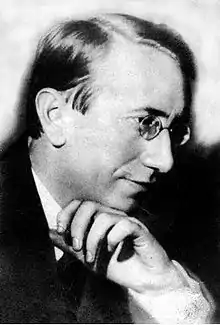Sigizmund Krzhizhanovsky
Sigizmund Dominikovich Krzhizhanovsky (Russian: Сигизму́нд Домини́кович Кржижано́вский, IPA: [sʲɪɡʲɪzˈmunt dəmʲɪˈnʲikəvʲɪtɕ krʐɨʐɨˈnofskʲɪj], Polish: Zygmunt Krzyżanowski; 11 February [O.S. 30 January] 1887 – 28 December 1950) was a Russian and Soviet writer, playwright, philosopher and historian, who described himself as "known for being unknown".[1] He published only a few stories and essays in his lifetime; the majority of his writings were published posthumously.[2]
Sigizmund Krzhizhanovsky | |
|---|---|
 Sigizmund Krzhizhanovsky | |
| Born | 11 February 1887 Kiev, Russian Empire (now Ukraine) |
| Died | December 28, 1950 (aged 63) Moscow, Russian SFSR, Soviet Union |
Life
Krzhizhanovsky was born in Kiev to a Polish family on 11 February 1887.[3]
Krzhizhanovsky was active among Moscow's literati in the 1920s, while working for Alexander Tairov's Chamber Theater. Several of Krzhizhanovsky's stories became known through private readings and a few publications. His writing style might have been influenced by Robert Louis Stevenson, G. K. Chesterton, Edgar Allan Poe, Nikolai Gogol,[4] E. T. A. Hoffmann, and H. G. Wells.[5]
In 1929 he penned a screenplay for Yakov Protazanov's acclaimed film The Feast of St Jorgen, yet his name did not appear in the credits. He also wrote the screenplay for the 1935 stop-motion animated feature film The New Gulliver, but, again, was left uncredited.[6] One of his last short stories, "Dymchaty bokal" ("The Smoke-Colored Goblet") from 1939, tells the story of a goblet miraculously never running out of wine, which is sometimes interpreted as a wry allusion to the author's fondness for alcohol.
Krzhizhanovsky died in Moscow, but his burial place is not known.
In 1976, scholar Vadim Perelmuter discovered Krzhizhanovsky's archive and in 1989 published one of his short stories. As the five volumes of his collected works followed, Krzhizhanovsky emerged from obscurity as a remarkable Soviet writer, who polished his prose to the verge of poetry. His short parables, written with an abundance of poetic detail and wonderful fertility of invention – though occasionally bordering on the whimsical – are sometimes compared to the ficciones of Jorge Luis Borges. "Quadraturin" (1926), the best known of such phantasmagoric stories, is a Kafkaesque tale in which allegory meets existentialism.
Bibliography
Collected works
- Vol. 1: Fairy-tales for Wunderkinder; The Wandering “Strangely”; Someone Else's Theme; Postmark: Moscow (2001).
- Vol. 2: The Letter Killers Club; The Return of Munchausen; Materials for the Biography of Gorgis Katafalaki; Memories of the Future; What Men Die By (2001).
- Vol. 3: Unbitten Elbow; One Smaller Than the Other; Collected Stories 1920s-1940s; Salyr-Gyul; Nice Sea; Moscow in the First Year of the War (2003).
- Vol. 4: The Poetics of Titles; Philosopheme about the Theater; Countries That Do Not Exist; Fragments about Shakespeare; The Art of the Epigraph [Pushkin]. Bernard Shaw's Dramatic Techniques (2006).
- Vol. 5: Theater projects; unfinished projects; juvenilia (2010).
- Vol. 6: Correspondence between Krzhizhanovsky and Anna Bovshek; memoirs; translations, documents, letters, photos (2013).
Novellas
- 1924: Странствующее «Странно». The Wandering “Strangely”.
- 1926: Клуб убийц букв. The Letter Killers Club, trans. Joanne Turnbull (New York Review Books, 2011). (ISBN 978-1-59017-450-0)
- 1927-1928: Возвращение Мюнхгаузена. The Return of Munchausen, trans. Joanne Turnbull (New York Review Books, 2016). (ISBN 978-1-68137-028-6)
- 1929: Материалы к биографии Горгиса Катафалаки. Materials for the Biography of Gorgis Katafalaki.
- 1929: Воспоминания о будущем (1989). Memories of the Future. Included in the collection translated by Joanne Turnbull (New York Review Books, 2009). (ISBN 978-1-59017-319-0)
Short story collections
- 1919-1927: Сказки для вундеркиндов. Fairy-tales for Wunderkinder.[2]
- 1927-1931: Чужая тема. Someone Else's Theme.
- 1932-1933: Чем люди мертвы. What Men Die By.
- 1940: Неукушенный локоть (Рассказы о Западе). Unbitten Elbow.
- 1937-1940: Мал мала меньше. One Smaller Than the Other.
- 1940: Сборник рассказов 1920-1940-х годов. Collected Stories 1920s-1940s.
Published essays and stories
- Якоби и „Якобы“ (1919). "Jacobi and 'As If'"
- Штемпель: Москва (1925). "Postmark: Moscow"
- Поэтика заглавий (1931). "The Poetics of Titles"
Translated stories and collections
- "Quadraturin", trans. Joanne Turnbull, in Russian Short Stories from Pushkin to Buida (Penguin, 2005). (ISBN 978-0-140-44846-7)
- 7 Stories, trans. Joanne Turnbull (GLAS New Russian Writing, 2006). (ISBN 5-7172-0073-0)
- Memories of the Future, trans. Joanne Turnbull (New York Review Books, 2009). (ISBN 978-1-59017-319-0)
- Autobiography of a Corpse, trans. Joanne Turnbull (New York Review Books, 2013). (ISBN 978-1-59017-670-2)
- Unwitting Street, trans. Joanne Turnbull (New York Review Books, 2020). (ISBN 978-1-68137-488-8)
References
- Tarves, Kirsten. "The lords of in-between: the trickster and liminal figure in the fiction of Sigizmund Krzhizhanovsky, 1925-1928". MSpace.
- Leiderman, N. L. (2012). "The Intellectual Worlds of Sigizmund Krzhizhanovsky". The Slavic and East European Journal. 56 (4): 507–535. ISSN 0037-6752. JSTOR 24392613.
- Adam Thirlwell, "Master of the Crossed Out," The New York Review of Books, vol. LVIII, no. 11 (June 23, 2011), p. 57.
- Serebrianik, Nina (2007-03-01). "Russian Short Stories from Pushkin to Buida". Translation Review. 73 (1): 71–76. doi:10.1080/07374836.2007.10524123. ISSN 0737-4836.
- H.G. Wells and All Things Russian. Anthem Press. 2019. ISBN 978-1-78308-991-8.
- Sigizmund Krzhizhanovsky. The Complete Works in 5 Volumes. Volume 1. ed. by Vadim Perelmuter. Saint Petersburg: Symposium, 2001, 688 pages. ISBN 5-89091-132-5
External links
- Review of Autobiography of a Corpse
- 'Yellow Coal', a short story by Krzhizhanovsky
- Review of recent Krzhizhanovsky translations from The Financial Times
- Review of Seven Stories
- Original texts of Krzhizhanovsky's stories (in Russian)
- A Man Who Was Gulliver: review of Krzhizhanovsky's complete works (in Russian)